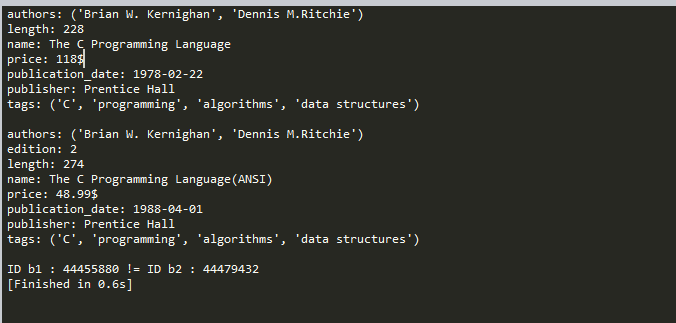设计模式-创建型模式,原型模式(3)
有时,我们需要原原本本地为对象创建一个副本。举例来说,假设你想创建一个应用来存储、
分享、编辑(比如,修改、添加注释及删除)食谱。用户Bob找到一份蛋糕食谱,在做了一些改
变后,觉得自己做的蛋糕非常美味,想要与朋友Alice分享这个食谱。但是该如何分享食谱呢?如
果在与Alice分享之后,Bob想对食谱做进一步的试验,Alice手里的食谱也能跟着变化吗?Bob能
够持有蛋糕食谱的两个副本吗?对蛋糕食谱进行的试验性变更不应该对原本美味蛋糕的食谱造
成影响。
这样的问题可以通过让用户对同一份食谱持有多个独立的副本来解决。每个副本被称为一个
克隆,是某个时间点原有对象的一个完全副本。这里时间是一个重要因素。因为它会影响克隆所
包含的内容。例如,如果Bob在对蛋糕食谱做改进以臻完美之前就与Alice分享了,那么Alice就绝
不可能像Bob那样烘烤出自己的美味蛋糕,只能按照Bob原来找到的食谱烘烤蛋糕。
注意引用与副本之间的区别。如果Bob和Alice持有的是同一个蛋糕食谱对象的两个引用,那
么Bob对食谱做的任何改变,对于Alice的食谱版本都是可见的,反之亦然。我们想要的是Bob和
Alice各自持有自己的副本,这样他们可以各自做变更而不会影响对方的食谱。实际上Bob需要蛋
糕食谱的两个副本:美味版本和试验版本。
# coding: utf-8 import copy from collections import OrderedDict class Book: def __init__(self, name, authors, price, **rest): '''rest的例子有:出版商,长度,标签,出版日期''' self.name = name self.authors = authors self.price = price # 单位为美元 self.__dict__.update(rest) def __str__(self): mylist = [] ordered = OrderedDict(sorted(self.__dict__.items())) for i in ordered.keys(): mylist.append('{}: {}'.format(i, ordered[i])) if i == 'price': mylist.append('$') mylist.append('\n') return ''.join(mylist) class Prototype: def __init__(self): self.objects = dict() def register(self, identifier, obj): self.objects[identifier] = obj def unregister(self, identifier): del self.objects[identifier] def clone(self, identifier, **attr): found = self.objects.get(identifier) if not found: raise ValueError('Incorrect object identifier: {}'.format(identifier)) obj = copy.deepcopy(found) obj.__dict__.update(attr) return obj def main(): b1 = Book('The C Programming Language', ('Brian W. Kernighan', 'Dennis M.Ritchie'), price=118, publisher='Prentice Hall', length=228, publication_date='1978-02-22', tags=('C', 'programming', 'algorithms', 'data structures')) prototype = Prototype() cid = 'k&r-first' prototype.register(cid, b1) b2 = prototype.clone(cid, name='The C Programming Language(ANSI)', price=48.99, length=274, publication_date='1988-04-01', edition=2) for i in (b1, b2): print(i) print('ID b1 : {} != ID b2 : {}'.format(id(b1), id(b2))) if __name__ == '__main__': main()

反对极端面向过程编程思维方式,喜欢面向对象和设计模式的解读,喜欢对比极端面向过程编程和oop编程消耗代码代码行数的区别和原因。致力于使用oop和36种设计模式写出最高可复用的框架级代码和使用最少的代码行数完成任务,致力于使用oop和设计模式来使部分代码减少90%行,使绝大部分py文件最低减少50%-80%行的写法。






【推荐】国内首个AI IDE,深度理解中文开发场景,立即下载体验Trae
【推荐】编程新体验,更懂你的AI,立即体验豆包MarsCode编程助手
【推荐】抖音旗下AI助手豆包,你的智能百科全书,全免费不限次数
【推荐】轻量又高性能的 SSH 工具 IShell:AI 加持,快人一步
· 从 HTTP 原因短语缺失研究 HTTP/2 和 HTTP/3 的设计差异
· AI与.NET技术实操系列:向量存储与相似性搜索在 .NET 中的实现
· 基于Microsoft.Extensions.AI核心库实现RAG应用
· Linux系列:如何用heaptrack跟踪.NET程序的非托管内存泄露
· 开发者必知的日志记录最佳实践
· winform 绘制太阳,地球,月球 运作规律
· AI与.NET技术实操系列(五):向量存储与相似性搜索在 .NET 中的实现
· 超详细:普通电脑也行Windows部署deepseek R1训练数据并当服务器共享给他人
· 上周热点回顾(3.3-3.9)
· AI 智能体引爆开源社区「GitHub 热点速览」